Related Research Articles

Earl of Warwick is a title in the Peerage of the United Kingdom which has been created four times in English history. The name refers to Warwick Castle and the town of Warwick.
The title of Baron Grey of Codnor is a title in the peerage of England.

The Lord Warden of the Cinque Ports is a ceremonial official in the United Kingdom. The post dates from at least the 12th century, when the title was Keeper of the Coast, but may be older. The Lord Warden was originally in charge of the Cinque Ports, a group of five port towns on the southeast coast of England that was formed to collectively supply ships for The Crown in the absence at the time of a formal navy. Today the role is a sinecure and an honorary title, and fourteen towns belong to the Cinque Ports confederation. The title is one of the higher honours bestowed by the Sovereign; it has often been held by members of the Royal Family or prime ministers, especially those who have been influential in defending Britain at times of war.
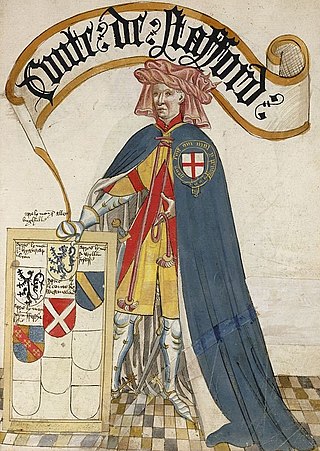
Ralph de Stafford, 1st Earl of Stafford, 2nd Baron Stafford, KG, of Stafford Castle and Madeley Castle in Staffordshire, was an English nobleman and a notable soldier during the Hundred Years' War against France.

Reynold Cobham, 1st Baron Cobham of Sterborough, KG (c.1295–1361) was a medieval English knight and diplomat.

Henry de Cobham, 1st Baron Cobham lord of the manor of Cobham, Kent and of Cooling, also in Kent, was an English peer.
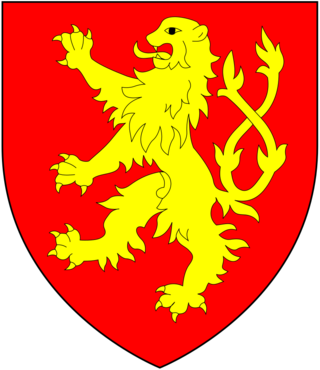
Bartholomew Burghersh, 1st Baron Burghersh, called "the elder", was an English nobleman and soldier, a younger son of Robert Burghersh, 1st Baron Burghersh and Maud Badlesmere, sister of Bartholomew Badlesmere, 1st Baron Badlesmere. He was the father of Bartholomew Burghersh the younger.

George Nevill, 5th Baron Bergavenny KG, PC, the family name often written Neville, was an English nobleman and courtier who held the office of Lord Warden of the Cinque Ports.
John Cobham, 3rd Baron Cobham, lord of the Manor of Cobham, Kent, was the son of John Cobham, 2nd Baron Cobham, and Joan Beauchamp, daughter of John Beauchamp, 1st Baron Beauchamp of Somerset. He was given a licence to crenellate by Richard II in 1381 and built Cooling Castle at the family seat at Cowling or Cooling, Kent.
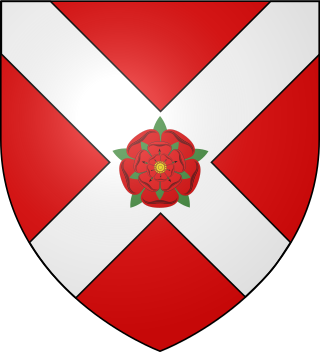
Edward Neville, de facto 3rd Baron Bergavenny was an English nobleman.

George Brooke, 9th Baron Cobham KG, lord of the Manor of Cobham, Kent and of Cooling Castle, Kent, was an English peer, soldier and magnate, who participated in the political turmoil following the death of King Henry VIII.

John Beauchamp, 1st Baron Beauchamp of Powick, KG, was an English nobleman and administrator. He was the son and eventual heir of Sir William Beauchamp of Powick in Worcestershire, Constable of Gloucester Castle, by his wife, Katherine Usflete, daughter and heiress of Sir Gerard de Usflete, a Member of Parliament for Yorkshire in 1401.
Margaret de Audley,suo jure2nd Baroness Audley and Countess of Stafford was an English noblewoman. She was the only daughter of Hugh de Audley, 1st Earl of Gloucester, by his wife Lady Margaret de Clare. Her mother was the daughter of Joan of Acre, Princess of England; thus making Margaret a great-granddaughter of King Edward I by his first consort, Eleanor of Castile. As the only daughter and heiress of her father, she succeeded to the title of 2nd Baroness Audley [E., 1317] on 10 November 1347.
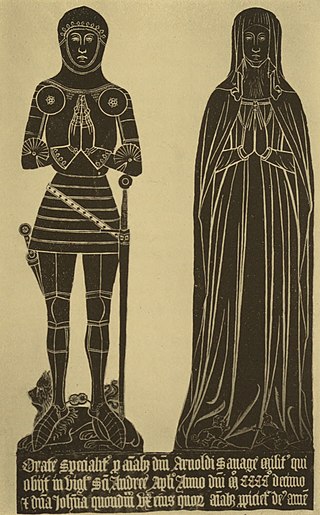
Sir Arnold Savage of Bobbing, Kent was the English Speaker of the House of Commons from 1400 to 1402 and then again from 1403 to 1404 and a Knight of the Shire of Kent who was referred to as "the great comprehensive symbol of the English people".

Katherine Mortimer, Countess of Warwick (c. 1314 – 4 August 1369) was the wife of Thomas de Beauchamp, 11th Earl of Warwick KG, an English peer, and military commander during the Hundred Years War. She was a daughter and co-heiress of Roger Mortimer, 1st Earl of March and Joan de Geneville, Baroness Geneville.
Sir Philip Despenser, Knt., of Goxhill, Lincolnshire was the son of Hugh Despenser, 1st Earl of Winchester and his wife, Isabella de Beauchamp, daughter of William de Beauchamp, 9th Earl of Warwick and Maud FitzJohn. He was born ca. 1290 in Stoke, Gloucester, England, and died on 24 September 1313. He married Margaret de Goushill, daughter of Ralph De Gousille and his wife Hawise Fitzwarine. Philip was brother to Hugh Despenser the Younger, a favorite of King Edward II.
Sir Thomas Burgh was an English gentleman.
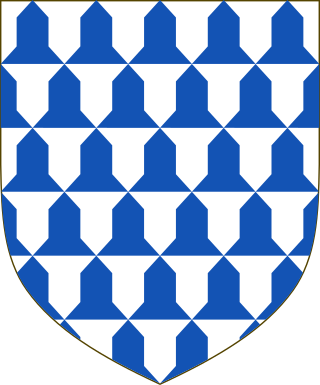
John de Beauchamp, 1st Baron Beauchamp "de Somerset", was feudal baron of Hatch Beauchamp in Somerset. He fought in the wars in Scotland and was a signatory of the Baron's Letter to Pope Boniface VIII in 1301.

The title Baron Cobham has been created numerous times in the Peerage of England; often multiple creations have been extant simultaneously, especially in the fourteenth century.

Brooke in the parish of Ilchester in Somerset, England, was an historic estate, the earliest known seat of the prominent Brooke family, Barons Cobham.
References
- ↑ Richardson, Douglas. Magna Carta Ancestry. Baltimore, MD: GPC, 2005. 902.